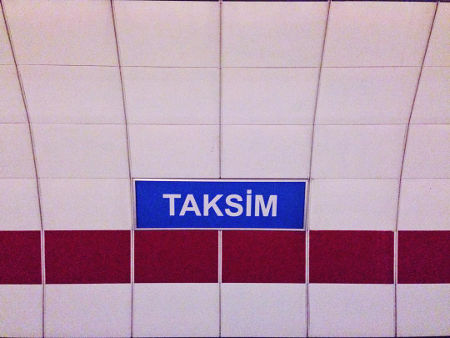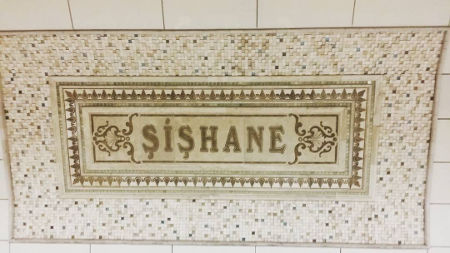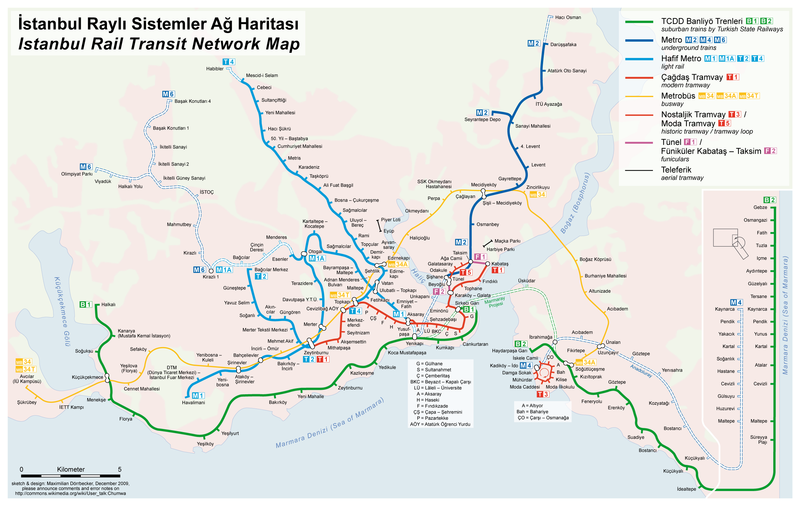Istanbul’s metro has 6 lines, 82 stations and a route of more than 100 kilometers (62 miles). It has a direct connection to the airport and a standard trip ticket costs 5 Turkish liras (a little more than 1 euro). The Istanbulkart can be used to store money for your metro trips. The metro system runs 7 days a week.
Introduction
Istanbul’s metro was the first metro system in Turkey. It’s a large system consisting of 6 lines that extend throughout the city on both the European and Asian side, allowing residents and visitors the ability to easily move from one side of Istanbul to the other.
The system in charge of the Istanbul metro is a public company that is also in charge of the tram and funicular systems.
The metro currently has 82 stations, distributed along 105.8 kilometers (65.7 miles) and six lines that connect at various points. Istanbul’s metro system is in the middle of a large expansion project in which the extension of four of the current lines and the opening of 8 additional lines is planned.
History
Although Istanbul has the second oldest funicular system in the world, the first metro line was not inaugurated until 1989, following various proposed plans and rejections from 1912 until 1987, when plans were finally accepted for what is now known as the M1 line.
The M1 line began operating on September 3, 1989. Initially it only covered Aksaray to Kocatepe. The construction of the second metro line, the M2 line began on September 11, 1992 and it was filled with challenges and problems due to the discovery of various archaeological sites during its excavation. This delayed and impeded construction. The line was finally opened to the public in 2000 and its current extension was completed in 2014.
In 2005 construction was approved on the first line that would extend to the Asian side of Istanbul and on August 17, 2012, the M4 line began to operate primarly from Kadıköy to Kartal and eventually to Tavşantepe.
The M3 line was next to operate. It was implemented in order to extend the M1B line. Its construction began in 2006 and it was opened to the public on June 14, 2013. The fourth line to operate was the M4 in April 2015, followed by the M6 line in 2015 and finally by the most recent, the M5 line, that was opened to the public in December 2017.
 Istanbul Metro
Istanbul Metro
Currently, the Istanbul metro is in the middle of an expansion project that includes the extension of 4 of the current lines and the opening of 8 new lines.
Lines and stations
The Istanbul metro has 6 lines that extend throughout the city taking both residents and visitors to almost anywhere in the city. Each of these lines has a code (M1, M2, etc.), a name and a color. Unlike (the world’s) other metro systems, it uses a code and a number and not the color to reference each of the lines.
M1 Line:
Opened to the public in 1989, this was the first metro line, not only for Istanbul but also for Turkey. This line offers 2 different services that share the first eight stations before splitting off to arrive at different terminals. The M1A line departs from Yenikapi and ends at the Atatürk airport, while the M1B line departs from Yenkapi and ends at Kirazli.
- Line color: Red
- Line number: 1
- Number of stations: 23
- Length: M1A: 20.3 kilometers (12.6 miles); M1B: 14 kilometers (8.7 miles)
- Total trip duration: M1A: 35 minutes; M1B: 25 minutes
- Schedule: 6:00 am to 12:00 am
Stations sharing lines M1A and M1B: Yenikapı , Aksaray , Emniyet-Fatih, Topkapı-Ulubatlı , Bayrampaşa-Maltepe, Sağmalcılar, Kocatepe, Otogar
M1A stations: Terazidere, Davutpaşa-YTÜ, Merter , Zeytinburnu , Bakırköy-İncirli , Bahçelievler , Ataköy—Şirinevler , Yenibosna , DTM—İstanbul Fuar Merkezi, Atatürk Havalimanı (Airport)
M1B stations: Esenler, Menderes, Üçyüzlü, Bağcılar Meydan , Kirazlı
M2 Line:
This is Istanbul metro system’s most used line. It connects the south of Sariyer with Fatih to the center of Istanbul, passing below Büyükdere Avenue and below Maslak and Levent, two important financial districts. Its respective terminals are Haciosman and Yenikapi.
- Line Color: Green
- Line number: 2
- Number of stations: 16 stations
- Line length: 23.5 kilometers (14.6 miles)
- Total trip duration: 30 minutes
- Schedule: 6:00 am to 12:00 am
Stations: Hacıosman, Darüşşafaka, Atatürk Oto Sanayi, İTÜ—Ayazağa, Sanayi Mahallesi, 4. Levent, Levent , Gayrettepe , Şişli—Mecidiyeköy , Osmanbey, Taksim , Şişhane , Haliç, Vezneciler , Yenikapı , Seyrantepe (depending on service)
M3 Line:
This line is an extension of the M1B line, departing from Kirazlı-Bağcılar terminal. The M3 line offers two services that share the first 5 stations and then split off at İkitelli Sanayi. One service ends at Metrokent since it is the M3 line’s official terminal, while the other ends at Olimpiyat.
- Line color: Blue
- Número de la línea: 3
- Number of stations: 11
- Line length: 15.9 kilometers (9.9 miles)
- Total trip duration: 20 minutes
- Schedule: 6:00 am to 12:00 am
Stations: Kirazlı, Yenimahalle, Mahmutbey, İSTOÇ, İkitelli Sanayi, Turgut Özal, Siteler, Başak Konutları, MetroKent, Ziya Gökalp Mahallesi, Olimpiyat
M4 Line:
This was the first line to operate on the Asian side of Istanbul. Its 19 stations extend completely underground. This line runs mostly under state highway D.100 and its terminals are Kadıköy and Tavşantepe.
- Line color: Pink
- Line number: 4
- Number of stations: 19
- Line length: 26.5 kilometers (16.5 miles)
- Total trip duration: 40 minutes
- Schedule: 6:00 am to 12:00 am
Stations: Kadıköy, Ayrılık Çeşmesi, Acıbadem, Ünalan, Göztepe, Yenisahra, Kozyatağı, Bostancı, Küçükyalı, Maltepe, Huzurevi, Gülsuyu, Esenkent, Hastane—Adliye, Soğanlık, Kartal, Yakacık—Adnan Kahveci, Pendik, Tavşantepe
M5 Line:
This was the second line to run on the Asian side of Istanbul and it was the first line to implement an automatic system that doesn’t require a conductor. The M5 line currently begins at Üsküdar station and extends to Yamanevler.
- Line color: Purple
- Line number: 5
- Number of stations: 9
- Line lenth: 20 kilometers (12.4 miles)
- Total trip duration: 16 minutes
- Schedule: 6:00 am to 12:00 am
Stations: Üsküdar, Fıstıkağacı, Bağlarbaşı, Altunizade, Kısıklı, Bulgurlu—Libadiye, Ümraniye, Çarşı, Yamanevler
M6 Line:
This is currently the shortest line on the Istanbul metro system, with only 3.3 kilometers (2.1 miles) and 4 stations. The M6 line extends from the M2 Line’s Levent station and ends at Boğaziçi Üniversitesi.
- Line color: Beige
- Line number: 6
- Number of stations: 4
- Line length: 3.3 kilometers (2.1 miles)
- Total trip duration: 7 minutes
- Schedule: 6:00 am to 12:00 am
Stations: Levent , Nispetiye, Etiler, Boğaziçi Üniversitesi
Schedule and frequency
All six of Istanbul’s metro lines operate six days a week, usually from 6:00 am to midnight. All the lines operate on Sunday, but some, like the M4 line, only run until 11:00 pm. The trains run every 6 to 10 minutes on every line most of the day and every 3 to 5 minutes during peak hours (7:00 am – 9:00 am and 5:00 pm to 7:00 pm).
Prices, tickets and passes
Istanbulkart:
This is the most practical and economical way to travel in Istanbul and it is accepted on other modes of transportation such as trams and funiculars. Each trip using the Instanbulkart is less than the price of an individual electronic ticket. It costs around 6 to 10 Turkish liras ($US 1.58 – US $2.63) depending on where you buy it.
 Istanbul Metro
Istanbul Metro
You can purchase it at any of the city’s airports, and at any of the machines located in every metro, bus, kiosk and store located throughout the city. However, if you purchase it from any of the station’s machine dispensers, you will pay 10 Turkish liras ($US 2.63) and the card will have just 4 Turkish liras ($US 1.05) left as a balance because the card itself costs 6 Turkish liras ($1.58).
The Istanbulkart is a plastic card in which money can be stored and used by up to 5 people traveling together. Istanbul’s metro system offers discounts for every transfer between metro lines or for connections to other systems. The discount increases according to the number of transfers. If more than one person is going to use the card, keep in mind that the discount for transfers only applies once. These discounts are valid for transfers made within two consecutive hours following the first trip.
Istanbulkart Fees:
- Ticket price: 6 to 10 Turkish liras ($US 1.58 – $US 2.63) depending on where you purchase it
- Price per trip: 2.60 Turkish liras ($US 0.68)
- First transfer 1.85 Turkish liras ($US 0.49)
- Second transfer: 1.40 Turkish liras ($US 0.37)
- Third, fourth and fifth transfer: 0.90 Turkish liras ($US 0.24)
Electronic tickets:
Although it is more expensive to use the Istanbulkart, it is possible to purchase electronic tickets for a set number of trips instead of disposable ones.
- 1 trip ticket: 5 Turkish liras ($US 1.32)
- 2 trip tickets: 8 Turkish liras ($US 2.11)
- 3 trip tickets: 11 Turkish liras ($US 2.90)
- 5 trip tickets: 17 Turkish liras ($US 4.48)
- 10 trip tickets 32 Turkish liras ($US 8.43)
Monthly pass:
The Istanbul metro doesn’t offer unlimited daily or weekly passes, but it does offer a monthly pass called the Blue Card. Monthly pass (Blue Car): 205 Turkish liras ($US 54)
Connections
Istanbul’s six metro lines are interconnected at various points, making it easy to move from one line to another or to any part of the city. Metro Istanbul, the public operator in charge of the metro system is also in charge of trams and funiculars. The connections throughout the system are well-structured and can be accessed with the Istanbulkart. The connections are not free but there are discounts depending on the number of transfers. These discounts can only be applied within two consecutive hours beginning from the time of the first paid trip and they are not valid for connections to the bus, ferry, Metrobus or Marmaray train line.
M1 Line:
- A connection can be made to the M2 line and the Marmaray train line at the Yenikapi station.
- A connection can be made to the M3 line from the M1B line at the Kirazli staion.
- A connection can be made to the T1 tram line at Aksaray, Zeytinburnu and Bağcılar Meydan stations
- A connection can be made from the T4 tram line at the Topkapı-Ulubatlı station.
- A connection can be made to the Metrobus at the Bahçelievler and Ataköy—Şirinevler stations.
M2 Line:
- A connection can be made to the M1 line and the Marmaray train line at Yenikapi station.
- A connection can be made to the M6 line from Levent station.
- A connection can be made to the T2 tram line and to the F1 funicular at the Taksim station
- A connection can be made to the T2 tram line and to the F1 funicular line at the Şişhane station.
- A connection can be made to the T1 tram line at Vezneciler station.
- A connection can be made to the F3 funicular at the Seyrantepe station.
- A connection to the Metrobus can be made at the Gayrettepe y Şişli—Mecidiyeköy stations.
M3 Line:
A connection can be made to the M1B line at Kirazli station.
M4 Line:
- A connection can be made to the Marmaray train at Ayrilik Cesmesi station.
- A connection can be made to the Metrobus at Ünalan station.
M5 Line:
- A connection can be made to the Marmaray train at Üsküdar station.
- A connection can be made to Metrobus at Altunizade station.
M6 Line:
- A connection can be made to the M2 line at Levent station.
- A connecton can be made to the F4 funicular at Boğaziçi Üniversitesi station.
Tips and attractions
- The Istanbulkart is the most economical way to purchase electronic tickets. The card costs around 10 liras, but if you plan to stay in Istanbul for a while, it is undoubtedly the most economical and practical use of the metro system.
- There are no free transfers between lines, but the Istanbul metro offers discounts depending on the number of connections.
- Istanbulkart can be used by up to five people traveling together, but the discount for connections or transfers only applies to the first person that boards each line.
- The construction of the second metro line was delayed and stopped various times due to the discovery of archaeological remains during the excavation.
- Most stations have a mezzanine, an underground entrance hall that connects to different entrances so that riders do not have to cross streets to access various platforms.
Future expansions
The Istanbul metro system is in the middle of an expansion project with an expected completion in 2023. This project not only includes the extension of current lines, but also the opening of four additional lines by 2019 and another three by 2023. Some of these lines are already being constructed and expect to begin running in 2018, while others are still in the planning process. Currently, there are about 62 stations under construction.
Extensions:
- 7 stations and 9 kilometers (5.6 miles) will be added to the M3 line.
- 4 stations and 7.4 kilometers (4.6 miles) will be added to the M4 line.
- 7 stations and 9.5 kilometers (6 miles) will be added to the M5 line.
New lines:
- At 24.5 kilometers (15.2 miles), the M7 line will connect Kabataş to Mahmutbey and is expected to begin operating in 2019.
- At 14.27 kilometers (8.7 miles), the M8 line will connect Bostancı-İDO with Dudullu and is expected to begin operating in 2019.
- At 13 kilometers (8 miles), the M9 line will connect Ataköy con İkitelli and is expected to begin operating in 2019.
- At 37.2 kilometers (23.1 miles), the M11 line will connect Gayrettepe with Istanbul’s new airport and is expected to begin operating in 2019.
Connections with the airport
Istanbul has two airports and a third one under construction that is expected to be operational by the end of 2018. Currently, the Atatürk International Airport can only be reached using the Istanbul metro, but an extension project includes the new M11 line, that will reach the airport.
An extension on the M4 line is also planned to connect directly to the Sabiha Gokcen Airport.
Connection to Atatürk International Airport:
The M1A line ends directly at the Atatürk International Airport. This station can be found next to the international terminal and is connected to the domestic terminal by a pedestrian walkway. Once you have taken the M1A line, you can make a connection to the T1 tram at Zeytinburnu station to order to reach the Blue Mosque or any of the other metro line connections you’d like, such as the tram or funicular.
Sightseeing via metro
What we know today as Istanbul was once Constantinople and even further back was Byzantium. Constantinople was the capital of the Roman, Latin and Ottoman Empires. Seated in the middle of Europe and Asia, the city is full of testimonies of its historic past, including the many mosques, basilicas, cathedrals and bazaars. You can reach most of those destinations via the Istanbul metro.
Hagia Sophia or Santa Sophia Basilica: It was once the largest cathedral in the world and home to various religions throughout its history, as it shifted from a Greek Orthodox Basilica to a Roman Catholic Church. It is currently one of Istanbul’s icons, just as famous for its history as it is for its mosaics. You can reach the Santa Sophia Basilica by taking the M2 metro line to Vezneciler or the M1 line to Aksaray, Zeytinburnu and Bağcılar Meydan stations, followed by taking the T1 tram line, until you reach Sultanahmet.
Blue Mosque: Along with the Santa Sophia Basilica, the Blue Mosque is another one of Istanbul’s most significant icons as well as a major tourist site. Unlike the Basilica, the Blue Mosque still functions as a house of prayer for Muslims. Visiting it requires familiarizing yourself with the prayer schedule and the appropriate protocol to follow. The Blue Mosque is located near the Santa Sophia Basilica so the same metro directions can be followed.
Topkapi Palace: This palace is one of the memorials that the Ottoman Empire left behind. It currently has 27 towers and 5 kilometers (3.1 miles) of walls surrounding it. The palace is now a museum and one of Istanbul’s main tourist sites. In order to reach it, take the M2 metro to Vezneciler or the M1 line to the Aksaray, Zeytinburnu and Bağcılar Meydan stations , in order to connect to the T1, which you will ride until you reach Gulhane station.
Grand Bazaar: This is one of the oldest and largest bazaars in the world. Visitors can enjoy its more than 58 streets and 4,000 shops that offer an enormous selection of antiques, rugs, jewelry, and more. In addition to the exotic shops, this bazaar is also home to fountains, mosques and hammams known as Turkish baths. The Grand Bazaar is a 10 minute walk from the M2 line’s Vezneciler station.
Istanbul metro map
- Passengers/Day More than one million
- Fares:
- 24h operation: No
- Air Conditioning: No
- Walk between platforms: No
- Driverless trains: No
- Screen Doors Platforms: No
- Operator: Metro Istanbul
- 2.30 TL
- Istanbul Metro Official Website
- Tlf: +90 212 568 99 70
Help us
If you consider that the information we provide is wrong, not accurated, outdated, translation contains errors, and you would like to help us to improve the file...you can contact us here.
Feel free to contact us if you dont find the system you're looking for and we'll add it as soon as we can!
Thank you very much!









